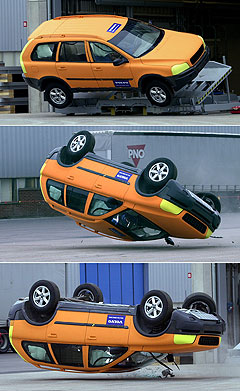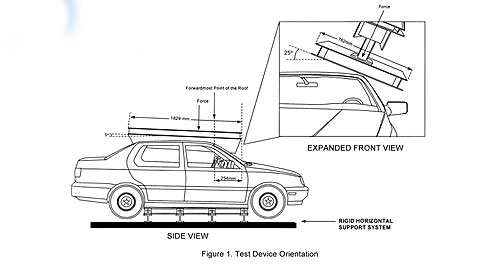Make / Model Search
News - General NewsTest lab to probe car roof crushHitting the roof: Volvo puts one of its vehicles under the pump with a roll-over test. Aussie cars to come under scrutiny for roll-over strength in independent tests29 Mar 2010 THE roof strength of Australian cars finally will be tested, despite the absence of a relevant Australian Design Rule (ADR). A group led by the NSW Injury Risk Management Research Centre will begin testing the roof strength of locally-produced vehicles in the next six to 12 months. At this stage the tests will be done independently of the Australian New Car Assessment Program (ANCAP) crash test operation, although it is interested in the outcomes and may present the data in future. The tests will rate roof crush using a system that has been in operation in the US for decades – not be confused with a dynamic rollover test, which safety groups around the world are working towards. NSW Risk Management Centre chair of road safety, Prof Raphael Grzebieta, said current ADRs did nothing to test the roof strength of vehicles. “You could have a roof made out of spaghetti and still pass the ADRs,” he told GoAuto at last week’s SAE Change by Design forum in Melbourne. “Unfortunately, we have a pretty pathetic federal government in terms of introducing Australian design rules that we know would change the safety of vehicles.” Mr Grzebieta said road safety experts have been pushing for tests to improve roof strength for years, but no progress had been made. “We keep getting the excuses coming back about harmonisation with the rest of the world, and that is a crock because we were the first to introduce seatbelts, we were the first to introduce breath tests, we were the first to introduce three point seat belts on to buses and had the rollover tests for buses,” he said. “That was in the good times when the federal office of road safety tuned into safety issues.” Mr Grzebieta said roof strength and rollover protection was vehicle safety’s ‘last frontier’ and needed to be addressed.  “There are roughly 10,000 deaths a year in the US from rollover crashes, it is huge,” he said. “There are roughly 10,000 deaths a year in the US from rollover crashes, it is huge,” he said.“In Australia, we went back through the fatality data and have come up with a figure of somewhere around 25-30 per cent of crashes there has been a fatality when the vehicle has rolled over. That doesn’t necessarily mean the fatality has been caused by the rollover, but it has rolled.” Improving roof strength could reduce the rate of fatalities and cut injury rates, Mr Grzebieta said. “We have been doing a lot of work on rollovers and we now know that if you do strengthen the roof, you reduce the severity of the impact load to the head and neck significantly,” he said. “You can walk away from the crash rather than end up in a wheelchair.” He said tests such as ANCAP were addressing other kinds of impacts, but not those that test roof strength. “There are less deaths from frontal and side impacts than from rollovers. Rollovers have now overtaken them because nothing has been done about it.” The NSW Risk Management Research Centre will use the US 216 roof test which forces a weight 1.5 times the vehicle’s mass down on to a vehicle’s A-pillars. “What we want to do is rate Australian vehicles that have not undergone that test,” Mr Grzebieta said. “The National Highway Transport Safety Administration (NHTSA) has done a heap of US models, but not European or Australian models, so we want to get the Australian vehicles in there. “We want to add it to the consumer table so that consumers can say ‘does this vehicle have a strong roof?&rsquo.” He said one of the key players in the push for improved roof strength was the mining industry, which has also led the push for more safety equipment in particular vehicles. “The mining industry is sick and tired of having to fit their vehicles with rollover cages. It is crazy,” Mr Grzebieta said. The NSW Risk Management Research Centre is also part of a push to develop a dynamic rollover crash test along with two several Australian groups and two universities in the US. “We are building what is called the Jordan rollover test system in the RTA’s (Road Transport Authority) crash lab. “There is one going to be installed in the University of Virginia and another one in George Washington University and these three centres are going to work together and we are going to see if we can establish a dynamic rollover crash procedure. “There are still some hurdles to get through including crash test dummy, how do you get the airbags to trigger?“But that is what everyone is working towards in the next two to three years, but in the interim we are going to look at roof strength and we are going to rate those Aussie vehicles.” ANCAP is also studying the potential of a dynamic rollover test to add to its regime, along with a method of testing the capability of electronic stability control (ESC) systems. “It is an important issue, but we are not ready for rollover tests just yet,” said ANCAP chairman Lachlan McIntosh. “We need to see research and results,” he said. “There is still some work to be done (on a test).” He said he welcomed the roof crush test program the NSW Risk Management Research Centre was involved in and said ANCAP would be interested in the results.  Read more28th of January 2010  Five safety stars for TerritoryAustralia’s only locally built SUV scores a maximum five-star ANCAP safety rating16th of December 2009  Safety recall for Great Wall uteSeatbelt failure in crash test has repercussions as Great Wall’s V240 ute recalled20th of October 2009  Official: Holden builds the first-ever five-star uteGM Holden’s Commodore-based MY10 Ute earns a maximum five-star ANCAP rating |
Click to shareGeneral News articlesResearch General News Motor industry news |











Facebook Twitter Instagram